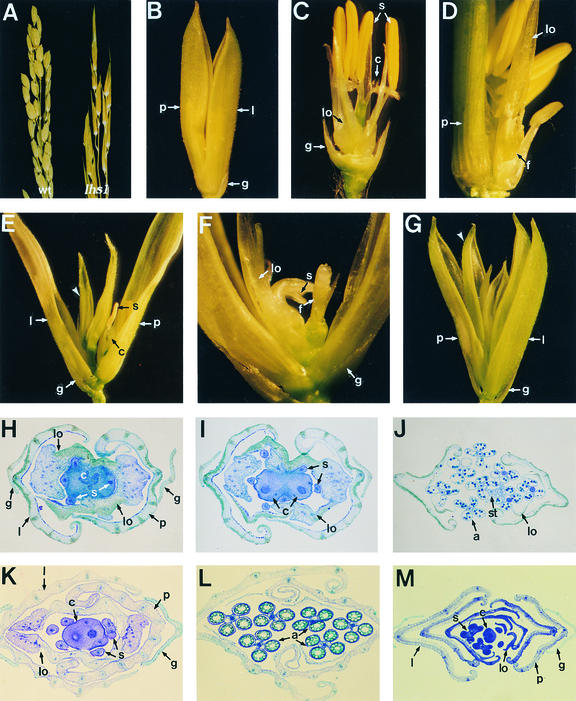Figure 6.
Spikelets from lhs1 and Transgenic Plants.
(A) Panicles from wild-type (left) and lhs1 (right) plants.
(B) A spikelet from the lhs1 mutant. The palea and lemma are overdeveloped in comparison with those of the wild type (see Figure 3B). The spikelet is open because of abnormal growth of leafy palea and lemma.
(C) A dissected lhs1 spikelet in which a palea and lemma were ripped off.
(D) An lhs1 spikelet generating a new floret.
(E) An lhs1 spikelet generating a new flower (arrowhead) consisting of leafy palea and lemma.
(F) An lhs1 spikelet generating a new flower in sequence.
(G) A transgenic spikelet from transgenic line 2145-9 generating multiple paleae and lemmas (arrowhead).
(H) A cross-section of an lhs1 spikelet. The spikelet consists of normal glumes, abnormal leafy palea and lemma, two pairs of leafy palea- and lemma-like lodicules, four stamens, and a carpel.
(I) A cross-section of an lhs1 spikelet. The spikelet consists of leafy palea and lemma, abnormal lodicules, six stamens, and two carpels.
(J) A cross-section of an lhs1 spikelet. The spikelet consists of two pairs of lodicules, eight stamens, and two carpels.
(K) A cross-section of a spikelet from a plant of transgenic line 2145-8.
(L) A cross-section of anthers of a spikelet from a plant of line 2145-8.
(M) A cross-section of a spikelet from a plant of line 2145-9, showing multiple paleae and lemmas.
a, anther; c, carpel; f, flower; g, glume; l, lemma; lo, lodicule; p, palea; s, stamen; st, stigma.

